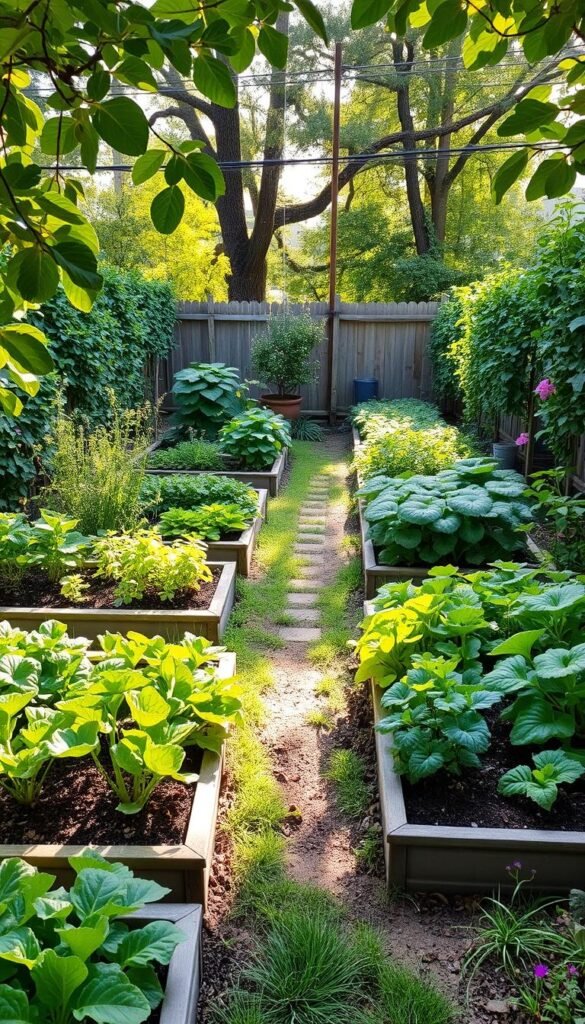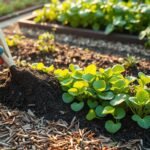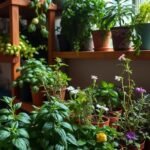Have you noticed how grocery bills keep climbing? You’re not alone. More Americans than ever are discovering the joys of growing fresh food right outside their doors. With smart planning, even compact outdoor areas can yield juicy tomatoes, crisp greens, and aromatic herbs.
This guide is your roadmap to creating a thriving edible oasis, no matter your experience level. Whether you’re working with a postage-stamp yard, a narrow side plot, or just a sunny balcony, you’ll learn how to turn underused spaces into delicious opportunities.
We’ll walk through practical strategies that blend form and function. Discover how to assess sunlight patterns, choose crops that thrive in your climate, and use vertical structures to multiply your growing area. You’ll get tips on container arrangements that look great while producing serious harvests.
By the end, you’ll know how to:
- Pair plants for maximum yield in tight quarters
- Use color and texture to create visual interest
- Maintain healthy soil without expensive products
Ready to transform that overlooked corner into your personal produce section? Let’s dig into techniques that make every inch count – because great flavor shouldn’t require acres of land.
Maximizing Your Outdoor Space: Understanding Small Garden Layouts
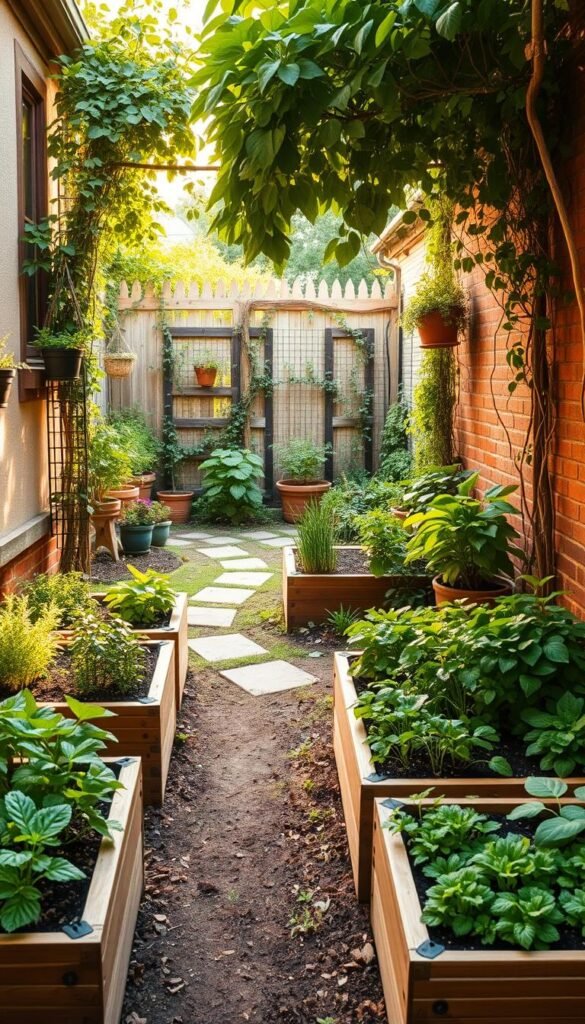
Did you know even a 4×4 foot plot can grow 50 pounds of tomatoes annually? Start by sketching your backyard layout on graph paper. Mark permanent structures like fences or patios first – these often make perfect supports for climbing plants.
Assessing Your Backyard Area
Track sunlight patterns for three days using a free app like Sun Seeker. Most edibles need 6+ hours of direct light. Notice where shadows fall from buildings or trees. South-facing spots usually get the strongest rays.
Measure your available space precisely. A 3-foot-wide path lets you reach plants comfortably. Use painter’s tape to outline potential beds on the ground before committing.
Identifying Functional Garden Zones
Divide your garden into four key areas:
| Zone Type | Purpose | Ideal Size |
|---|---|---|
| Growing Area | Primary planting beds | 60-70% of total space |
| Pathways | Access routes | 18-24″ width |
| Storage | Tools & supplies | Compact vertical unit |
| Compost | Soil enrichment | 3×3 foot bin |
Turn awkward corners into herb spirals or strawberry towers. Repurpose old ladders as vertical planters against sunny walls. Remember: good airflow prevents mold – leave 12″ between structures and plants.
Assessing Sunlight, Soil, and Climate for Your Vegetable Garden
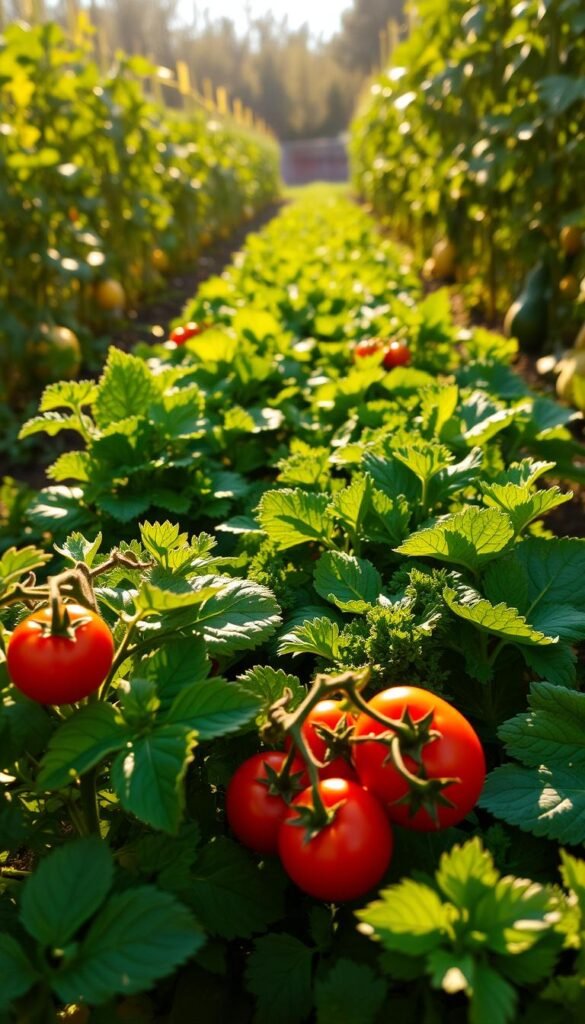
Ever wonder why some plants thrive while others barely survive? The secret lies in matching crops to your unique growing conditions. Three factors determine success: light availability, earth quality, and regional weather patterns.
Measuring Sunlight Exposure
Track light patterns over 3 days using a sun calculator app. Mark areas receiving 6+ hours of direct rays – prime real estate for tomatoes and peppers. Partial shade spots (4-6 hours) work for leafy greens like kale.
| Time of Day | Sun Survey Action | Crop Match |
|---|---|---|
| 8-10 AM | Identify morning light pockets | Lettuce, spinach |
| 12-2 PM | Measure peak intensity | Tomatoes, eggplant |
| 4-6 PM | Note late-day shadows | Herbs, root vegetables |
Testing and Amending Soil Quality
Dig a 6″ deep sample and squeeze it. Crumbly texture means good drainage. Use a $7 pH test kit from garden stores – most vegetables prefer 6.0-7.0 acidity.
Boost poor earth with these amendments:
| Soil Issue | Fix | Application Rate |
|---|---|---|
| Clay-heavy | Compost + peat moss | 3-inch layer |
| Sandy | Worm castings | 2 cups per sq ft |
| Acidic | Wood ash | 1 lb per 10 sq ft |
Remember: USDA zones dictate planting dates. Check your region’s last frost date using the Arbor Day Foundation’s zone map. Container gardens let you control conditions when nature doesn’t cooperate.
Planning Compact Garden Bed Designs
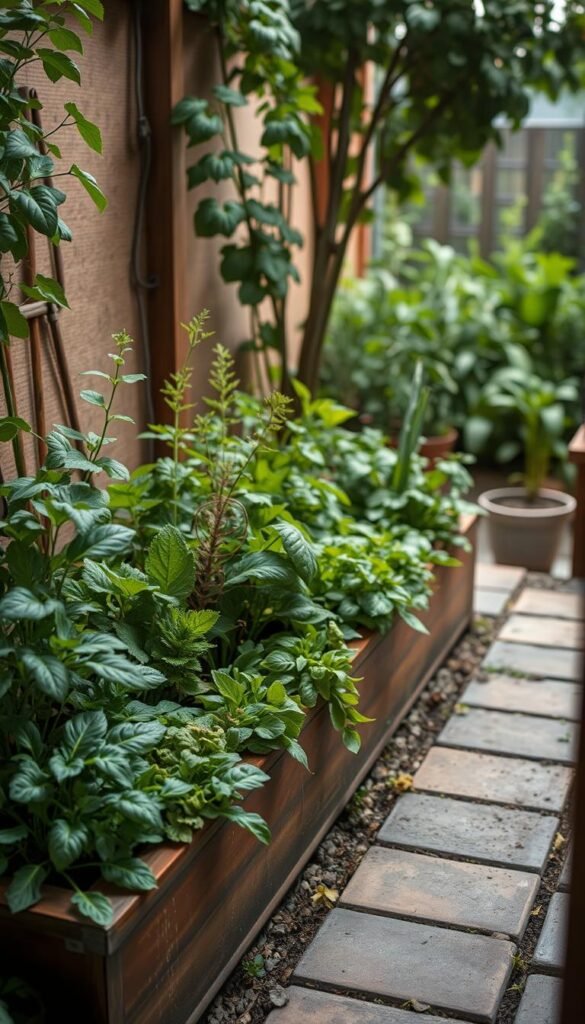
Urban growers face unique challenges, but smart bed designs can overcome them. Raised garden beds create a protective barrier between plants and contaminated soil – a common issue near roads or older buildings. These structures let you control drainage and nutrients while keeping maintenance simple.
Start with 4-foot-wide beds. This width lets you reach the center from both sides without compacting soil. Leave 18-inch pathways between beds for easy access with tools or harvest baskets. Here’s how to pair plants in tight quarters:
| Bed Size | Plant Pairing | Space Benefit |
|---|---|---|
| 4×4 ft | Tomatoes + Basil | Shared nutrients |
| 3×6 ft | Carrots + Radishes | Different root depths |
| 4×8 ft | Beans + Marigolds | Natural pest control |
Turn awkward corners into productive zones. Curve beds around fences or arrange them diagonally to fit narrow areas. Add trellises along the north side to grow vertical crops like peas without shading neighbors.
For those working with patios or balconies, these vegetable garden ideas show how modular planters can adapt to any layout. Mix edible flowers with herbs to create eye-catching patterns that boost biodiversity.
Remember: healthy soil means fewer inputs. Layer compost and worm castings annually to maintain fertility. Your small space can yield big flavors when every inch works smarter.
Small Vegetable Garden Design for Backyards: Making the Most of Minimal Space
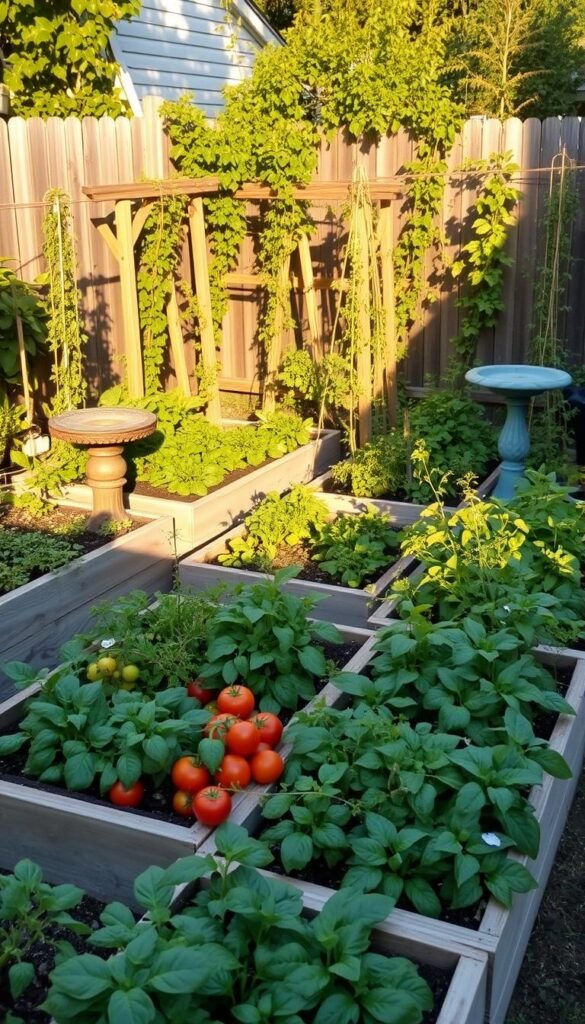
Who says you need a farm to enjoy homegrown flavors? Your edible landscape can burst with color and productivity using smart spatial strategies. Intensive growing methods let you harvest 3x more food from the same footprint through clever plant partnerships and vertical expansion.
Try this dynamic trio for tight quarters: leafy greens at ground level, bush beans in the middle, and cucumbers climbing upward. This layered approach turns a 4×4-foot bed into a three-dimensional buffet. Pair quick-growing radishes with slower-maturing carrots – you’ll harvest the first crop before the second needs room.
Create visual harmony while maximizing yield with these pairings:
| Season | Companion Plants | Space Advantage |
|---|---|---|
| Spring | Lettuce + Green Onions | Shallow roots share space |
| Summer | Peppers + Basil | Pest protection + flavor boost |
| Fall | Kale + Nasturtiums | Edible flowers attract pollinators |
Rotate crops every 60 days using succession planting. After pulling spring peas, replant with heat-loving okra.
“A well-planned plot produces 10 months of harvests with proper season extensions,”
notes urban farming expert Maria Cortez.
Blend beauty and bounty by edging beds with marigolds or lavender. Use curved pathways lined with thyme to soften geometric layouts. Self-watering planters on railings keep herbs within reach while adding greenery to your outdoor living area.
Start simple with modular containers that let you experiment. As your skills grow, add trellises or cold frames. Your cozy growing zone will evolve into a high-yield oasis that delights both the palate and the eye.
Maximizing Vertical Space: Trellises, Vines, and Air Gardens
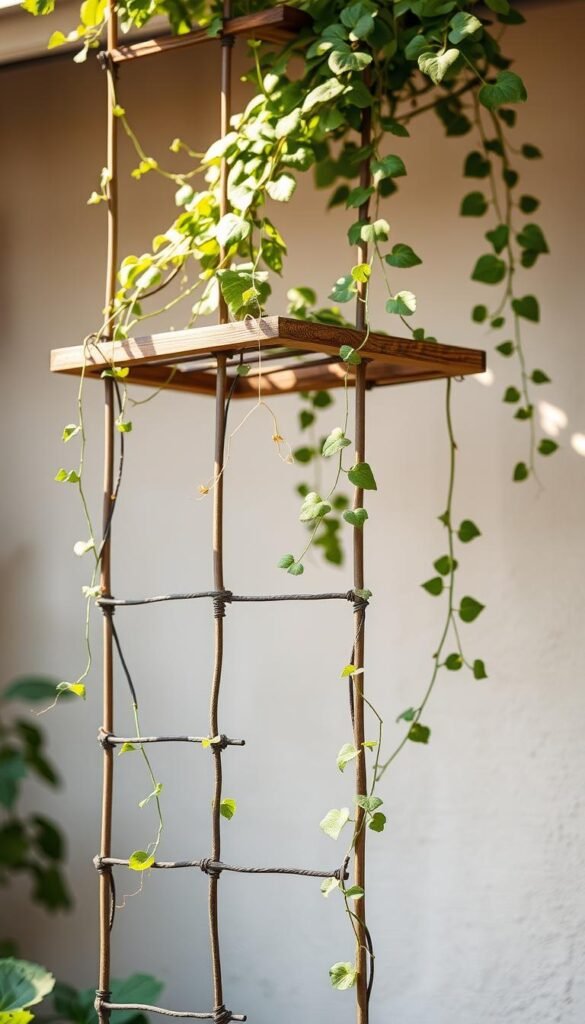
Imagine plucking fresh beans from your living room wall. Vertical growing systems let you harvest climbing crops at eye level while freeing up precious ground space. This approach isn’t just practical – it transforms blank walls and fences into lush, edible tapestries.
Choosing the Right Vertical Supports
Match your structure to plant needs. Lightweight mesh works for peas and morning glories, while cucumbers and squash demand sturdy metal frames. Consider these options:
| Crop Type | Ideal Support | Weight Capacity |
|---|---|---|
| Pole Beans | Bamboo teepees | 15 lbs |
| Tomatoes | Cattle panel arches | 50+ lbs |
| Melons | Nylon sling systems | 10-20 lbs |
Urban gardener @seekthemeec proves recycled materials shine – their balcony uses repurposed ladders as bean scaffolds.
Drawing Inspiration from Instagram Garden Trends
Social media stars redefine vertical gardens daily. @AireVePots showcases hydroponic walls growing strawberries in nutrient mist. Their secret? A drip system that uses 90% less water than soil beds.
Try these space-smart ideas:
- Hanging pocket planters for herbs
- Retractable clothesline trellises
- Tiered shelves with trailing nasturtiums
“Vertical growing lets me harvest 3x more food without expanding my footprint,”
Maintain your aerial oasis with weekly root checks and drip irrigation. Rotate crops seasonally – swap summer beans for fall peas to keep your vertical support structures productive year-round.
Exploring Container Options: Pots, Planters, and Window Boxes
What if your balcony could become a salad bar? The right containers turn overlooked ledges and corners into productive growing zones. Modern solutions blend practicality with style, letting you harvest fresh ingredients steps from your kitchen.
Benefits of Self-Watering Planters
Busy schedules won’t wilt your greens with these smart systems. A built-in reservoir supplies moisture for 3-5 days, perfect for weekend getaways. Plants drink at their own pace, reducing root rot risks.
| Planter Type | Best For | Water Capacity |
|---|---|---|
| Window Box | Lettuce & herbs | 1.5 gallons |
| Tiered Unit | Strawberries | 3 gallons |
| Vertical Tower | Leafy greens | 5 gallons |
Tips for Selecting the Best Containers
Match your plants’ needs to these features:
| Material | Pros | Ideal Plants |
|---|---|---|
| Terracotta | Natural airflow | Rosemary, thyme |
| Fabric Bags | Prevents overwatering | Tomatoes, peppers |
| Plastic | Lightweight | Basil, mint |
Repurpose old colanders as quirky herb pots – their holes offer built-in drainage. For tomatoes, choose 20-gallon grow bags that let roots spread. Shallow window boxes? Perfect for radishes and spinach.
Rotate plants seasonally. Swap summer cucumbers for fall kale in the same planter. Add casters to heavy containers for easy sunlight chasing. Your limited space will burst with flavors!
Designing Raised Beds and DIY Garden Structures
Elevated growing spaces aren’t just trendy—they’re practical solutions for challenging yards. Raised beds lift plants above poor ground conditions while reducing strain on your back. Let’s explore how to create these efficient systems that boost yields in tight areas.
Choosing Raised Bed Materials
Popular options balance durability and cost. Cedar resists rot naturally, lasting 10-15 years untreated. Galvanized steel offers modern appeal with 20+ year lifespans. Compare key features:
| Material | Cost | Longevity |
|---|---|---|
| Cedar | $$ | 10-15 years |
| Composite | $$$ | 15+ years |
| Steel | $$$$ | 20+ years |
For quick setups, pre-cut 3’x6′ kits work well. Build larger 4’x4′ units if space allows. Avoid treated wood near edible plants—chemicals can leach into soil.
Building a Simple Backyard Raised Bed
Follow these steps for success:
- Clear grass and level the ground
- Assemble frame using weather-resistant screws
- Line bottom with hardware cloth to deter burrowers
Fill beds with quality mixes like Coast of Maine Organic Raised Bed Blend. This premium soil retains moisture better than regular dirt. Mix in compost annually to replenish nutrients.
Space multiple beds 2 feet apart for easy access. Rotate crops yearly—swap heavy feeders like tomatoes with nitrogen-fixing beans. For detailed how to build raised beds guidance, check our step-by-step resource.
Incorporating Hydroponics and Vertical Towers
What if you could grow vegetables without touching dirt? Modern hydroponic systems let you cultivate lush greens and juicy tomatoes using nutrient-rich water instead of soil. These space-saving solutions work wonders for balconies, patios, or even kitchen counters.
Starting Your Hydroponic System
Begin with a simple deep water culture setup. You’ll need a reservoir, air pump, and net pots. Leafy greens like kale thrive here, growing 30% faster than in traditional beds. Choose from three main system types:
| Type | Best For | Water Use |
|---|---|---|
| NFT | Herbs & lettuce | Low |
| Ebb & Flow | Strawberries | Moderate |
| Aeroponics | Root vegetables | Minimal |
Mix liquid nutrients according to package instructions. Test pH weekly with strips – most plants prefer 5.5-6.5 levels. Start small with a hydroponic tower system that holds 12-18 seedlings.
Maintaining a Vertical Garden Tower
Keep roots healthy with these essentials:
- Flush reservoirs every 2 weeks
- Trim dead leaves promptly
- Rotate towers for even light exposure
Expect higher upfront costs – quality systems run $150-$300. But you’ll save long-term on water and soil amendments. Troubleshoot cloudy water by reducing nutrients 20% and increasing oxygenation.
Vertical setups let you harvest 8x more food per square foot. Pair compact cherry tomatoes with trailing nasturtiums for a stunning edible display. Your growing space just got a high-tech upgrade!
Balancing Aesthetics and Functionality with Garden Décor
What if your outdoor space could dazzle the eye while boosting harvests? Strategic décor choices transform practical growing areas into inviting retreats. By blending style with purpose, you create spaces that nourish both body and soul.
Using Terracotta Pots for Style and Drainage
These classic clay containers offer timeless charm and practical benefits. Their porous walls allow roots to breathe, preventing waterlogged soil. Arrange them in clusters of three or five near seating areas for visual impact.
Pair terracotta with sleek metal planters or woven baskets to add texture. Fill them with herbs like rosemary or thyme – their silvery foliage complements the pots’ warm hues. For compact patio designs, mix varying pot heights to create depth without clutter.
Remember functionality: ensure all containers have drainage holes. Elevate pots with feet or stones to improve airflow. Rotate plantings seasonally – swap summer basil for winter kale to keep your garden décor fresh year-round.
Your outdoor oasis should reflect personal flair while serving practical needs. With thoughtful arrangements, every planter becomes both artwork and harvest station.
